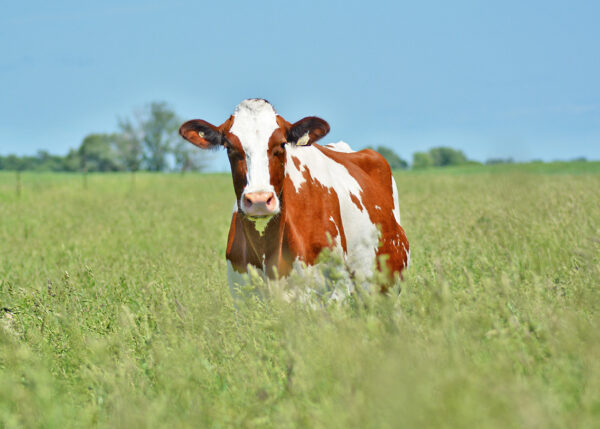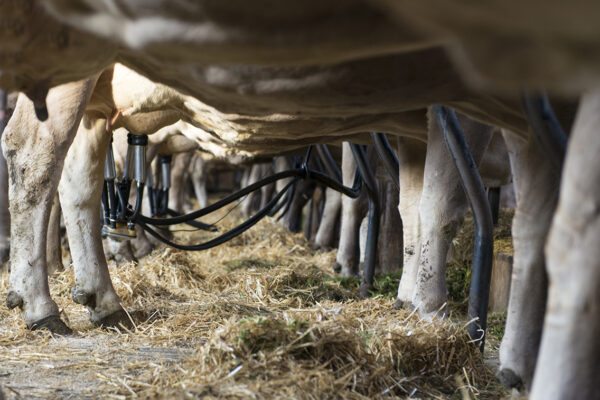Something is robbing your fresh cows’ calcium stores – and it’s not milk production
By Nathan Upah
Late at night, after the drone of the pumps are quiet, every producer has wondered, “How could I get more out of my cows?” As most good questions do, this too leads to another question. “Nutritionally, what is holding fresh cows back from maximum production?”
Historically, the blame was placed on calcium, or a lack thereof. Hypocalcemia was viewed as an epidemic, with more than 40% of fresh cows testing below target calcium thresholds. At first glance it made logical sense: Calcium is required to produce milk. And as a result of genetic advancement, they were increasingly capable of higher production. High production demands combined with relatively low dry matter intake (DMI) left cows with insufficient calcium levels.
Hypocalcemia hysteria started. Peer-reviewed and published studies noted cows that were not hypocalcemic had a lower incidence of metabolic disease. Hypocalcemia gained steam and, to some, became the gateway metabolic disorder. The belief was: If nothing was done to address a fresh cow’s calcium status, she would then have a markedly increased risk of experiencing a slew of metabolic diseases following a bout of hypocalcemia.
To mitigate hypocalcemia, it became a standard practice to supplement the cow with a large dose of oral calcium salts. Several subsequent studies ensued, attempting to validate the concept of delivering oral calcium post-freshening.

Some of the largest or most detailed studies failed to show a herd-level benefit in oral calcium supplementation. Specifically, oral calcium supplementation failed to improve milk production, had a detrimental effect on reproduction in primiparous cows and did not impact body condition score.
This historic conversation on hypocalcemia could now be turning on a couple of different theorems. What if hypocalcemia is a symptom and not the problem? What if the cow didn’t read the publications and isn’t terribly concerned about maintaining blood calcium above 8.4 milligrams per deciliter?
Turning to research, cows that were challenged with endotoxin were observed to become hypocalcemic. Reactionary hypocalcemia.
But fresh cows aren’t sick when they calve, right? Further research followed and observed high levels of immune system activity and high levels of endotoxin in cows during the pre-fresh period and in the days following calving in cows eventually diagnosed and treated for a metabolic disease. This would propose that some fresh cows are sick at the time of calving, and together peer-reviewed and published studies would also suggest that a cow’s calcium status is not being influenced by milk production alone.

Unfortunately, it is impossible to tell based on serum calcium alone if a cow’s subclinical hypocalcemia is due to high production or if she has low blood calcium because she’s sick. “Why does it matter?” you might ask. Because the appropriate treatment differs.
High-producing cows with hypocalcemia benefit from calcium supplementation. Conversely, research out of Iowa State University would suggest that immuno-activated dairy cows may not show benefit from receiving calcium as the sole form of nutritional intervention.
Why are transition cows sick, and where are these toxins coming from? There are multiple reasons the immune system could be turned on prior to calving. Multiple studies have observed immune system activation in animals during parturition, heat stress, suboptimal feed intake and even cognitive or physical stressors. The infiltration of toxins is likely possible due to a deterioration of epithelial tissue (rumen, intestine, uterine, etc.) and depressed barrier function, but the direct source of toxin infiltration is not yet known and may, in fact, be different for each cow.
The difficult question stemming
from scientific discovery is:
How can producers treat a larger disease that presents the same symptoms as a nutritional deficiency?
We start by eliminating the variables that cause stress:
- Commingling – How many times are we putting new cows into pre-fresh pens? Every time cows are added, the hierarchy must be re-established.
- Overcrowding – What is the stocking density of my pre-fresh pen?
- Feed restriction – How many hours a day are my pre-fresh cows without feed? Are we moving cows to designated calving pens without feed for long periods of time?
- Digestive upset – How much sorting is occurring? Is forage preserved in a manner to limit the amount of molds and toxins we are feeding? Is DCAD under control, or is consistent acidification a problem?
Hypocalcemia should no longer be receiving the attention as the “gateway metabolic disease.” Calcium deficiency should be thought of as either a symptom of immune system activation or a symptom of high production. The sun should be setting on the days of giving a large dose of just oral calcium to the herd and expecting a response.
The most effective weapon producers have in the battle of fresh cow health is DMI. Facilitation of DMI for periparturient cows sounds like an old mantra but is truer today than ever before. The wrongs of a poor pre-fresh period cannot be unwritten even with the best fresh pen care. Remember, the fresh cow has multiple nutrient needs; milk isn’t just made of calcium.
We need to stop chasing efficient levels of a single nutrient. Her intake in the hours post-freshening is critical to long-term lactation success but, unfortunately, her diet alone is probably not enough. A diet can be balanced perfectly, but if she’s not eating to the target-formulated level of intake, she will remain deficient in multiple nutrients. Consider evaluating nutritional supplements to help bridge the nutritional gap based on what is beneficial for increasing DMI. Now we know, fresh cow recovery requires more than just calcium.
Article first published on Progressive Dairy. Read it here.
